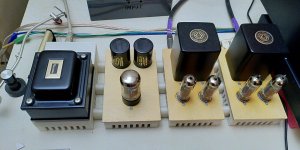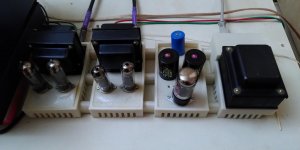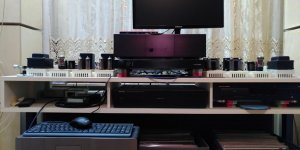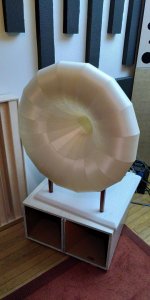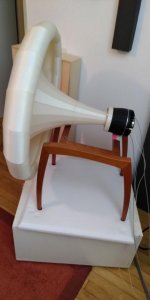Measurements
As a preview/teaser, I would like to present some measurements of my system. It comprises of bandpass subwoofers, basshorns and mid-high horns. It looks like a 3-way but it is a 4 way. A Minidsp 8x10HD is the heart of the system. The amplification for subwoofers and basshorns is solid-state, the mid and high portions of the BMS 4592ND drivers are fed with a signal from low power tube amps. The midrange and tweeters are as such biamped, by the way.
I have applied acoustic treatment in the form of a mix of basstraps, diffusion and absorption. The room measures 5.28m by 4.15m with half open rear wall to dining room and kitchen. Total length of room is 8.6m. Listening position is about 1.2m from rear wall (the rear wall that matters is 5.28m from the front. To the left of me the room extends, to my back and to the right I have the mentioned rear wall. So my room is not very symmetrical.
About the measurements: these are taken from the listening position, only one measurement. All screenshots are taken from this measurement, exept the subwoofer measurement., where the mic was placed very close to the port of the subwoofer. The subwoofers have also been included in the total system measurement, so the measurement range is plm 20hz-20khz.
I tried to place the mic as close to the "middle line" between the speakers as possible, at the listening position. The speakers are on their usual/quasi optimal position. I must note that I am not yet finished dialling in the system after the latest upgrade of my system. Also, I am just starting to understand how to measure loudspeakers well, so please take the measurements with a grain of salt. I may have made errors, but nevertheless I guess it is entertaining enough .
.
At a later stage in this thread, I will show some more details about the system, the build of the 3D printed horns and especially explain about the choices I made over time to create this system as it is now.
I hope the horn afficionados (and of course all others who build speakers) like my effort it is by all means not perfect, but it is a very musical sounding system I dare say.
it is by all means not perfect, but it is a very musical sounding system I dare say.
Edit: the SPL/phase graph is total system output with subwoofers included
As a preview/teaser, I would like to present some measurements of my system. It comprises of bandpass subwoofers, basshorns and mid-high horns. It looks like a 3-way but it is a 4 way. A Minidsp 8x10HD is the heart of the system. The amplification for subwoofers and basshorns is solid-state, the mid and high portions of the BMS 4592ND drivers are fed with a signal from low power tube amps. The midrange and tweeters are as such biamped, by the way.
I have applied acoustic treatment in the form of a mix of basstraps, diffusion and absorption. The room measures 5.28m by 4.15m with half open rear wall to dining room and kitchen. Total length of room is 8.6m. Listening position is about 1.2m from rear wall (the rear wall that matters is 5.28m from the front. To the left of me the room extends, to my back and to the right I have the mentioned rear wall. So my room is not very symmetrical.
About the measurements: these are taken from the listening position, only one measurement. All screenshots are taken from this measurement, exept the subwoofer measurement., where the mic was placed very close to the port of the subwoofer. The subwoofers have also been included in the total system measurement, so the measurement range is plm 20hz-20khz.
I tried to place the mic as close to the "middle line" between the speakers as possible, at the listening position. The speakers are on their usual/quasi optimal position. I must note that I am not yet finished dialling in the system after the latest upgrade of my system. Also, I am just starting to understand how to measure loudspeakers well, so please take the measurements with a grain of salt. I may have made errors, but nevertheless I guess it is entertaining enough
At a later stage in this thread, I will show some more details about the system, the build of the 3D printed horns and especially explain about the choices I made over time to create this system as it is now.
I hope the horn afficionados (and of course all others who build speakers) like my effort
Edit: the SPL/phase graph is total system output with subwoofers included
Attachments
-
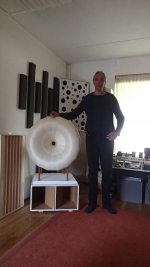 Hoorns en ik.jpg52.9 KB · Views: 841
Hoorns en ik.jpg52.9 KB · Views: 841 -
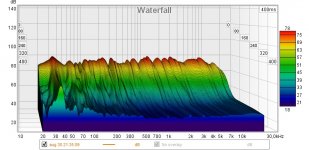 Bass and midhigh at listening pos waterfall.jpg116.6 KB · Views: 670
Bass and midhigh at listening pos waterfall.jpg116.6 KB · Views: 670 -
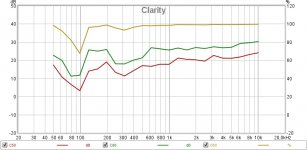 Bass and midhigh at listening pos clarity.jpg72.7 KB · Views: 428
Bass and midhigh at listening pos clarity.jpg72.7 KB · Views: 428 -
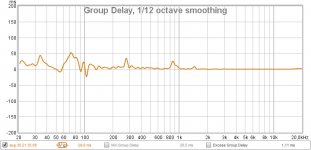 Bass and midhigh at listening pos GD.jpg78.6 KB · Views: 541
Bass and midhigh at listening pos GD.jpg78.6 KB · Views: 541 -
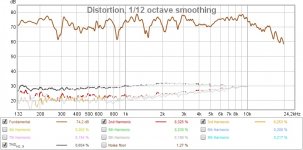 Bass and midhigh at listening pos distortion.jpg102.5 KB · Views: 519
Bass and midhigh at listening pos distortion.jpg102.5 KB · Views: 519 -
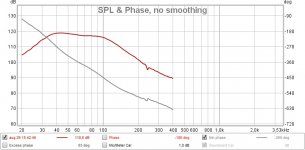 Dayton Subwoofer meting poort.jpg86.8 KB · Views: 545
Dayton Subwoofer meting poort.jpg86.8 KB · Views: 545 -
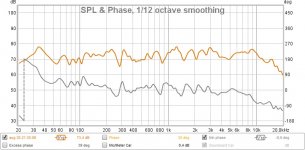 Bass and midhigh at listening pos.jpg89.5 KB · Views: 790
Bass and midhigh at listening pos.jpg89.5 KB · Views: 790
Last edited:
Good morning Horneydude,
congratulations with these measurements/results. It's the well-deserved output of your audio-dedication.
Although our systems are really different (i'm into K-tubes and open baffles) we have common ground on low powered tube gear (...pictures please...). And the audio hobby on its own of course.
When looking at your pictures i can't recollect i saw you at Breda or Hengelo at Welkom op zelfbouwaudio.nl events ? But i could be mistaken. During these Corona-times all interesting audio-gatherings are skipped/cancelled anyway.
Hope to see more of your interesting audio gear.
Regards,
Reinout
latest projects:
Tweeter amplifier (1 kHz upwards...)
Fieldcoil + K-tube
congratulations with these measurements/results. It's the well-deserved output of your audio-dedication.
Although our systems are really different (i'm into K-tubes and open baffles) we have common ground on low powered tube gear (...pictures please...). And the audio hobby on its own of course.
When looking at your pictures i can't recollect i saw you at Breda or Hengelo at Welkom op zelfbouwaudio.nl events ? But i could be mistaken. During these Corona-times all interesting audio-gatherings are skipped/cancelled anyway.
Hope to see more of your interesting audio gear.
Regards,
Reinout
latest projects:
Tweeter amplifier (1 kHz upwards...)
Fieldcoil + K-tube
@Horneydude: Are you still here? I would like to know the details of your system, pictures of horns, subwoofers, amps, everything How much filament did you use, which printer and how long did it take to print?
How much filament did you use, which printer and how long did it take to print?
Hi, stunning work.Measurements
As a preview/teaser, I would like to present some measurements of my system. It comprises of bandpass subwoofers, basshorns and mid-high horns. It looks like a 3-way but it is a 4 way. A Minidsp 8x10HD is the heart of the system. The amplification for subwoofers and basshorns is solid-state, the mid and high portions of the BMS 4592ND drivers are fed with a signal from low power tube amps. The midrange and tweeters are as such biamped, by the way.
At a later stage in this thread, I will show some more details about the system, the build of the 3D printed horns and especially explain about the choices I made over time to create this system as it is now.
I hope the horn afficionados (and of course all others who build speakers) like my effortit is by all means not perfect, but it is a very musical sounding system I dare say.
Can you give more details of 3D printed horns ?
Also, what crossover points are you using, especially on BMS 4592ND.
Many thanks in advance
Barry
Hi Barry, thanks for your compliments. It took me half a lifetime to arrive where I am at now soundwise: learning, dreaming and building (less than I should have, but means...). The sound is amazing (to me), like good headphones without the shells, seamless integration of all parts etc, few colorations, hardly any measurable distortion, wide and deep soundstage, incredible dynamics and enveloping like only horns do (my opinion). No "horn sound" or shouting, no jumping of tones, just music. The latest development is the implementation of a battery off-grid system (for prepping) and the system sounds even better now, using a pure sine converter. Since the pollution from the public power network has been eliminated, all kind of audiophile goodies come out even better. Nice bonusHi, stunning work.
Can you give more details of 3D printed horns ?
Also, what crossover points are you using, especially on BMS 4592ND.
Many thanks in advance
Barry
The horns have been printed on a "standard size" printer. 22 parts for one horn, glued together. Le'Cleach contour, full 360 degrees horn termination as described by Le'Cleach. Only do-able with 3D printing. They cover a range of 300hz upwards, but I filter at 500hz with 24dB LR. I have lived with the 4592ND for almost 20 years now (early adopter) and I have finally managed to make it sing in this horn, but it took a lot of time and measurements. It's a b*tch to get it right, but it can sound wonderful. If you do it wrong, it will irritate the heck out of your ears. I will not reveal the exact settings (yet), but maybe doing so is pointless because in a different horn, the settings will probably also be different.
Without DSP it will be difficult to reach the 4592ND's real potential according to my experience, but I will not say it is impossible by other means. I have "bi-amped" the 4592ND using two stereo flea powered, <1 watt/ch tube power amps I built. Filter settings are "unconventional and out of the box", no PEQ's used on the 4592ND, a little on the bass horn and subs. Max sound pressure in room is about 110dB due to the limited available power, but more than enough in my situation.
The "minimalist" approach resulted in a nice stack of gear, lol. But that is not a joke, I have eliminated all passive filters and the tube amps only have one cathode resistor and one capacitor in the signal path (apart from the power supply, trannies etc). Time alignment is your friend if you are into horns. A friend compared the sound to be of the same "quality" as +50.000 dollar setups, so I must be doing something right. Weakest point in the signal chain is the (unmodified) minidsp, but for it's price it's great value.
I will post some more pictures soon. I got distracted by real world problems like the covid hoax, so posting here was not in my mind for a while.
Last edited:
Sorry for not responding... I will continue the tread soon. One new message posted. Thank you for your attention.Hello,
I also am curious about your path, as you said "especially explain about the choices I made over time to create this system as it is now."
Thanks!
Correct. But I won't do that again, very time consuming and a hassle. But you get a good horn this way. I have printed another set of horns in the same way. Maybe just maybe I might sell the second pair. But the parts have to be glued together still, so the parts are stored in a cardboard box until I feel horny again.how do you print a horn so big ? do you do it in parts and then glue them together ?
Last edited:
The horn consist of 22 pieces glued together, so when running out of filament, you start again although it is a waste of an unfinished part obviously. So not running out of filament is key here.What I would like to know is how you exchange filament while the object is not finished printing. What you do when you run out?
As promised, some more photo's of my listening room, which will also reveal my room treatment. And some pictures showing more detail of the horns and tube amps. As I have some nice binaural microphones, I am intending to make a binaural recording from where I sit for listening and share it somehow. But that will be another project, so let's stick with photo's for now. Also, I need to write down some considerations why this system is like it is and sound like it sounds. Noisewise, you can stick your head in the horn but you won't hear a thing unless you play some music.
First photo: midrange amp with 3D printed housing
Second photo: prototype 3D printed, it has melted somehow and it survived a violent emergency stop in my car but still functions as my tweeter amp. Lafayette iron by the way, sounds nice on it's own.
Third photo: combination Rotel solid state and tube amps. Solid state for midbass and subs, tube for mid/high. I want tube for midbass too, but regarding the power consumption of tube amps, that has to wait until energy prices are lower.
Forth photo: mid/high horn 3D printed, front view
Fifth photo: mid/high horn 3D printed, side view
Sixth photo anorama photo of the listening space with bass traps, diffusers and absorption. The ceiling has also been treated.
anorama photo of the listening space with bass traps, diffusers and absorption. The ceiling has also been treated.
First photo: midrange amp with 3D printed housing
Second photo: prototype 3D printed, it has melted somehow and it survived a violent emergency stop in my car but still functions as my tweeter amp. Lafayette iron by the way, sounds nice on it's own.
Third photo: combination Rotel solid state and tube amps. Solid state for midbass and subs, tube for mid/high. I want tube for midbass too, but regarding the power consumption of tube amps, that has to wait until energy prices are lower.
Forth photo: mid/high horn 3D printed, front view
Fifth photo: mid/high horn 3D printed, side view
Sixth photo
Attachments
Last edited:
This is a first test of recording my speakers trough a binaural microphone set I have at hand. These are in-ear mics, but they are not really suitable to wear in-ear as they fall off very easily and they tend to twist due to the cords. This recording is in-ear and will be better when my "headset" is finished. The stereo image is somewhat to the left, not nicely centered due to not well seated mics. Recording is with my own head as dummy head, from the listening position. Still a nice taste of what is possible 
Randy Brecker, 47th N-Lex album, Let it Go
ps sorry for the tilted view, I had a funny smoke (bad banana)
Randy Brecker, 47th N-Lex album, Let it Go
ps sorry for the tilted view, I had a funny smoke (bad banana)
Last edited:
I posted some info on the amp here: https://www.diyaudio.com/community/threads/photo-gallery.71300/post-7216468
- Home
- Loudspeakers
- Multi-Way
- 3D printed horn system
